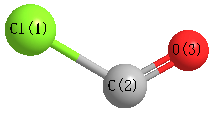Jump to
S1C2
Energy calculated at MP2/Def2TZVPP
| | hartrees |
|---|
| Energy at 0K | -572.786876 |
| Energy at 298.15K | -572.786387 |
| HF Energy | -572.239520 |
| Nuclear repulsion energy | 79.161372 |
The energy at 298.15K was derived from the energy at 0K
and an integrated heat capacity that used the calculated vibrational frequencies.
Geometric Data calculated at MP2/Def2TZVPP
Point Group is Cs
Cartesians (Å)
| Atom |
x (Å) |
y (Å) |
z (Å) |
|---|
| Cl1 |
-0.497 |
-0.912 |
0.000 |
| C2 |
0.000 |
0.842 |
0.000 |
| O3 |
1.057 |
1.306 |
0.000 |
Atom - Atom Distances (Å)
| |
Cl1 |
C2 |
O3 |
| Cl1 | | 1.8225 | 2.7078 |
C2 | 1.8225 | | 1.1543 | O3 | 2.7078 | 1.1543 | |
 More geometry information
More geometry information
Calculated Bond Angles
| atom1 |
atom2 |
atom3 |
angle |
|
atom1 |
atom2 |
atom3 |
angle |
| Cl1 |
C2 |
O3 |
129.529 |
|
Electronic energy levels
Charges, Dipole, Quadrupole and Polarizability
Jump to
S1C1
Energy calculated at MP2/Def2TZVPP
| | hartrees |
|---|
| Energy at 0K | -572.776113 |
| Energy at 298.15K | -572.774089 |
| HF Energy | -572.259727 |
| Nuclear repulsion energy | 57.661715 |
The energy at 298.15K was derived from the energy at 0K
and an integrated heat capacity that used the calculated vibrational frequencies.
Geometric Data calculated at MP2/Def2TZVPP
Point Group is C∞v
Cartesians (Å)
| Atom |
x (Å) |
y (Å) |
z (Å) |
|---|
| Cl1 |
0.000 |
0.000 |
1.596 |
| C2 |
0.000 |
0.000 |
-1.293 |
| O3 |
0.000 |
0.000 |
-2.422 |
Atom - Atom Distances (Å)
| |
Cl1 |
C2 |
O3 |
| Cl1 | | 2.8891 | 4.0179 |
C2 | 2.8891 | | 1.1287 | O3 | 4.0179 | 1.1287 | |
 More geometry information
More geometry information
Calculated Bond Angles
| atom1 |
atom2 |
atom3 |
angle |
|
atom1 |
atom2 |
atom3 |
angle |
| Cl1 |
C2 |
O3 |
180.000 |
|
Electronic energy levels
Charges, Dipole, Quadrupole and Polarizability
